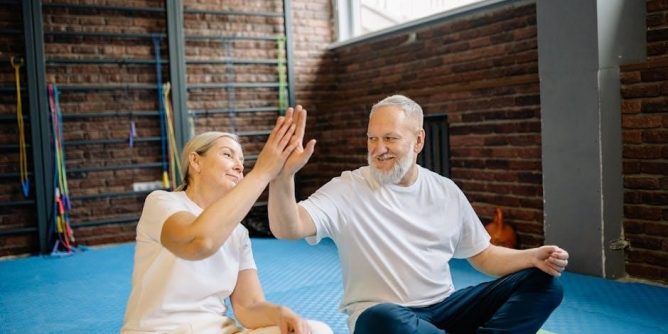
Sciatica, involving the sciatic nerve, causes lower back, buttock, and leg pain․ It’s common in seniors, with most cases occurring between 45-64 years․ Gentle exercises, like stretches and strengthening movements, are key to managing symptoms and improving mobility, especially when guided by healthcare professionals․ Printable PDF resources offer structured routines for home use, aiding in pain relief and prevention․
1․1 What is Sciatica?
Sciatica refers to pain that radiates along the sciatic nerve, the longest nerve in the body, extending from the lower back through the buttocks and into the legs․ It often results from irritation or compression of the nerve roots in the lower back; Symptoms include lower back pain, numbness, tingling, or burning sensations in the buttocks, hips, and legs․ Sciatica is most common in individuals aged 45–64 years and can significantly impact daily activities․ While it is not a medical condition itself but rather a symptom of an underlying issue, such as a herniated disc or spinal stenosis, most cases improve with conservative treatments like stretching exercises, physical therapy, and lifestyle adjustments․ Understanding sciatica is crucial for developing effective management strategies, especially for seniors seeking to maintain mobility and reduce discomfort․
1․2 The Role of the Sciatic Nerve
The sciatic nerve, the longest nerve in the human body, plays a vital role in controlling leg movements and sensation․ It originates in the lower back, formed by nerve roots from the lumbar and sacral spine, and extends down both legs․ The sciatic nerve is responsible for controlling key muscle groups in the thighs, calves, and feet, enabling walking, running, and maintaining balance․ Damage or compression of this nerve can lead to sciatica, causing pain, numbness, or weakness in the lower extremities․ In seniors, age-related spinal changes, such as herniated discs or spinal stenosis, often contribute to sciatic nerve irritation․ Understanding the nerve’s function is essential for developing targeted exercises to relieve sciatica symptoms and improve mobility in older adults․
1․3 Sciatica Prevalence Among Seniors
Sciatica prevalence among seniors is significant, with most cases occurring between the ages of 45 and 64․ Studies estimate a lifetime incidence of 10-40%, though the majority of individuals recover within time without surgery․ Aging contributes to spinal changes, such as degenerative discs or stenosis, increasing sciatica risk․ Seniors are more prone due to these age-related factors․ Understanding this prevalence is crucial for early intervention and effective management strategies tailored to older adults․ While common, sciatica in seniors is manageable with appropriate care and exercises, emphasizing the importance of proactive health measures․

Causes and Symptoms of Sciatica in Seniors
Sciatica in seniors often results from degenerative discs, spinal stenosis, or piriformis syndrome․ Symptoms include lower back pain, numbness, tingling, and limited mobility, affecting daily activities and comfort․
2․1 Common Causes of Sciatica
Sciatica in seniors is often caused by degenerative disc disease, spinal stenosis, or piriformis syndrome․ Herniated discs and spondylolisthesis can compress the sciatic nerve, leading to pain․ Age-related wear and tear on the spine, such as reduced disc height and ligament stiffness, increases the risk․ Additionally, poor posture or years of repetitive strain can exacerbate nerve irritation․ Obesity and lack of physical activity may also contribute by placing extra pressure on the lower back․ Understanding these causes helps tailor exercises and therapies to address the root issue, promoting effective relief and improved mobility for seniors with sciatica․
2․2 Recognizing Symptoms
Sciatica symptoms in seniors often include sharp or dull pain radiating from the lower back through the buttocks and down one leg․ Numbness, tingling, or a burning sensation may accompany this pain․ Symptoms can worsen with activities like sitting, coughing, or bending․ Pain relief is often felt when lying down or walking with a stooped posture․ Weakness in the affected leg or foot is also common․ Sciatica typically affects individuals aged 45–64, with symptoms varying in intensity․ Early recognition of these signs is crucial for effective management and preventing further discomfort․ Understanding these indicators helps seniors and caregivers identify the condition and seek appropriate exercises or therapies to alleviate discomfort and enhance mobility․
2․3 How Age Affects Sciatica
Aging significantly impacts the development and severity of sciatica in seniors․ As individuals age, spinal discs degenerate, increasing the risk of herniation and nerve compression․ Weakened core and gluteal muscles reduce support for the lower back, exacerbating sciatic nerve irritation․ Additionally, reduced flexibility and mobility in seniors can lead to tight muscles, further contributing to sciatica symptoms․ Older adults may experience slower recovery times due to decreased healing capacity․ However, gentle exercises and stretches can help mitigate these effects, improving mobility and reducing pain․ Age-related factors make it essential for seniors to adopt tailored exercise routines to manage sciatica effectively and maintain an active lifestyle․

The Role of Exercise in Managing Sciatica
Exercise plays a crucial role in managing sciatica by reducing pain, improving mobility, and strengthening muscles․ Gentle stretches and low-impact activities help alleviate symptoms and prevent recurrence, especially in seniors․
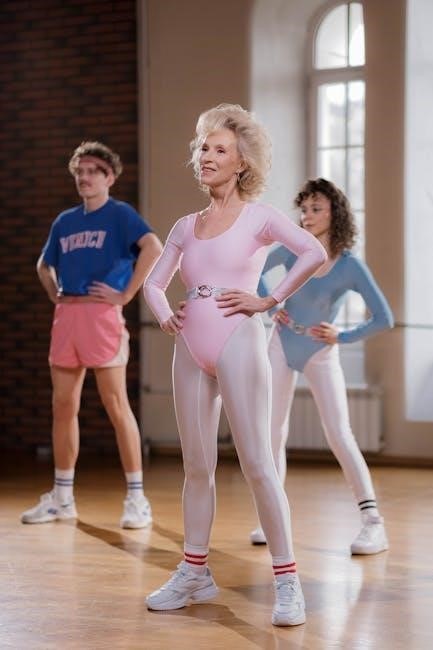
3․1 How Exercises Help with Sciatica
Exercises play a vital role in managing sciatica by addressing its root causes, such as tight muscles, poor posture, or nerve compression․ Stretching exercises, particularly for the piriformis and hamstrings, help relieve tension that may irritate the sciatic nerve, reducing pain and discomfort․ Strengthening exercises for the core and lower back muscles improve stability, reducing strain on the spine and nerves․ Gentle movements enhance blood flow, promoting healing and relaxation․ Regular exercise also improves flexibility and mobility, making daily activities easier for seniors․ By targeting specific muscle groups, exercises can prevent sciatica flare-ups and foster long-term pain relief, helping seniors maintain an active and independent lifestyle․
3․2 Importance of Stretching
Stretching is a cornerstone of managing sciatica, especially for seniors, as it alleviates muscle tightness and nerve irritation․ Targeted stretches for the hamstrings, piriformis, and hip flexors can reduce pressure on the sciatic nerve, providing immediate pain relief․ Regular stretching improves flexibility, allowing for better mobility and reducing the risk of further injury․ Additionally, stretching promotes blood circulation, which aids in healing and reduces inflammation․ For seniors, gentle and controlled stretches are particularly beneficial, as they can be performed at home or in bed, making them accessible and sustainable․ Incorporating stretching into a daily routine helps maintain muscle balance and prevents sciatica symptoms from worsening, ensuring seniors can enjoy improved comfort and independence in their daily lives․
3․3 Tips for Starting an Exercise Routine
Starting an exercise routine for sciatica management requires careful planning and patience; Always consult a healthcare professional to ensure exercises are safe and appropriate for your condition․ Begin with gentle, low-impact movements, such as seated stretches or short walks, to avoid aggravating the sciatic nerve․ Incorporate breathing techniques to enhance relaxation and reduce discomfort during exercises․ Consistency is key; aim for short, daily sessions rather than overexerting in one workout․ Use printable PDF guides to track progress and stay motivated․ Listen to your body and stop if pain increases, adjusting the routine as needed․ Combining exercises with other therapies, like heat or ice, can further alleviate symptoms and promote healing․
Effective Sciatica Exercises for Seniors
Gentle stretches like Figure Four, Seated Glute Stretch, and Cat-Cow help relieve sciatica pain․ Strengthening exercises, such as Bridging and Clamshell, improve core and pelvic stability․ Perform these exercises slowly and carefully to avoid discomfort, ideally 2-3 times a week․ Many can be done at home or in bed, making them accessible for seniors with mobility challenges․ Printable PDF guides provide clear instructions and visuals, ensuring proper form and safety․ Regular practice can significantly reduce pain and enhance overall mobility, promoting a better quality of life for seniors managing sciatica․
4․1 Figure Four Stretch
The Figure Four Stretch is a highly effective exercise for relieving sciatica pain, particularly when caused by tightness in the piriformis muscle․ To perform this stretch, lie on your back with knees bent and feet flat on the floor․ Cross your right ankle over your left knee, keeping your right foot flexed․ Gently pull your left knee toward your chest using your hands or a strap until a stretch is felt in the buttocks․ Hold for 20-30 seconds, then repeat on the other side․ This stretch can also be done while seated, making it accessible for seniors with mobility challenges․ Deep breathing during the stretch enhances relaxation and reduces tension․ Avoid bouncing or forcing the stretch beyond a comfortable range to prevent discomfort․ Regular practice helps alleviate sciatic pain and improves flexibility․
4․2 Seated Glute Stretch
The Seated Glute Stretch is an excellent exercise for seniors to alleviate sciatica pain by targeting the glutes and piriformis muscle․ Sit comfortably with your back straight, feet flat on the floor, and knees bent․ Cross your right ankle over your left knee, keeping your foot flexed․ Gently lean forward from your hips until a stretch is felt in your right buttock․ Hold for 20-30 seconds, then switch sides․ This stretch can also be performed in bed for convenience․ Deep breathing during the stretch helps relax the muscles․ Avoid bouncing or forcing the stretch to prevent discomfort․ Regular practice of this stretch improves flexibility, reduces sciatic discomfort, and enhances overall lower body mobility․ It’s an accessible and effective option for seniors managing sciatica at home․
4․3 Cat-Cow Stretch
The Cat-Cow Stretch is a gentle, effective exercise for seniors to relieve sciatica pain and improve spinal flexibility․ Start on your hands and knees (all fours), with your spine in a neutral position․ Inhale deeply and arch your back, lifting your head and tailbone toward the ceiling (Cow Pose)․ Then, exhale slowly and round your spine, tucking your chin to your chest and your pelvis toward the floor (Cat Pose)․ Repeat this sequence 5-10 times, moving slowly and synchronizing your breath with each movement․ This stretch gently mobilizes the lower back, eases tension in the sciatic nerve, and enhances posture․ For added comfort, seniors can perform this stretch while seated in a chair by leaning forward and arching backward․ Regular practice helps reduce stiffness and promotes better spinal mobility, making it an ideal exercise for managing sciatica symptoms․
4․4 Bridging Exercise
The Bridging Exercise is a low-impact, effective stretch for seniors to alleviate sciatica pain․ Lie on your back with knees bent and feet flat on the floor․ Slowly lift your hips toward the ceiling, squeezing your abdominal muscles to support your lower back․ Hold for 5-10 seconds, then gently lower your hips back down․ This exercise strengthens the glutes and lower back muscles while stretching the hamstrings, helping to reduce sciatic nerve pressure․ For added comfort, seniors can perform this exercise with a pillow under the knees․ Regular practice improves posture, reduces stiffness, and enhances mobility, making it an excellent addition to a sciatica management routine․ This gentle movement is particularly beneficial for those with limited mobility, as it can be done in bed or on the floor with proper support․
4․5 Clamshell Exercise
The Clamshell Exercise is a gentle, effective stretch targeting the glutes and hip muscles, which can help relieve sciatica pain․ To perform this exercise, lie on your side with knees bent and feet touching․ Slowly lift the top knee toward the ceiling while keeping the feet together, then hold for 5-10 seconds before lowering․ This movement strengthens the gluteal muscles and improves hip alignment, reducing pressure on the sciatic nerve․ Seniors can modify this exercise by placing a pillow between the knees for added comfort․ Regular practice helps enhance stability, reduce stiffness, and improve overall lower body mobility․ It’s an excellent low-impact option for managing sciatica symptoms, especially for those with limited flexibility or mobility issues․
4․6 Gentle Seated Twist
The Gentle Seated Twist is an excellent exercise for improving spinal flexibility and alleviating sciatica-related tension․ To perform this exercise, sit comfortably with feet flat on the floor․ Slowly twist your torso to one side, placing your hand on the outer thigh for gentle guidance․ Hold this position for 20-30 seconds before returning to the starting position and repeating on the other side․ This stretch helps release tight muscles in the lower back and hips, which often contribute to sciatic pain․ Seniors can modify the twist by using a chair or keeping the back straight․ Regular practice enhances posture, reduces stiffness, and promotes circulation, making it an ideal exercise for managing sciatica symptoms in a safe and controlled manner․
Modifications and Safety Tips
Adapt exercises to suit mobility levels, use chairs or beds for support, and practice gentle movements․ Focus on controlled breathing to avoid strain and consult healthcare professionals before starting any routine․

5․1 Adapting Exercises for Mobility
Adapting exercises for mobility is crucial for seniors, ensuring safety and effectiveness․ Many exercises can be modified to accommodate physical limitations․ For instance, stretches like the Figure Four or Seated Glute Stretch can be performed while seated or lying down, reducing strain on the lower back․ Chairs or bed supports are often recommended to enhance stability and comfort․ Gentle movements and controlled breathing can help prevent overexertion․ Additionally, exercises can be broken into shorter sessions to avoid fatigue, making them more manageable․ Consulting with healthcare professionals to tailor routines to individual needs is highly advised․ This approach ensures exercises are both safe and beneficial for seniors with mobility challenges․
5․2 Breathing Techniques During Exercise
Proper breathing techniques are essential for seniors performing sciatica exercises, as they help manage pain and reduce muscle tension․ Deep, controlled breathing can promote relaxation and improve focus during stretches․ Inhale deeply through the nose, filling the lungs fully, and exhale slowly through the mouth, especially during the most challenging part of the movement․ This rhythmic pattern helps maintain stability and prevents overexertion․ Breathing techniques also enhance blood flow and oxygen delivery to muscles, which can aid in healing and reduce stiffness․ Consistent practice of these methods ensures exercises are performed safely and effectively, making them more enjoyable and beneficial for long-term mobility and pain relief․
5․3 Consulting Healthcare Professionals
Consulting healthcare professionals is crucial for seniors starting sciatica exercises, ensuring safety and effectiveness․ They assess individual conditions, such as the cause of sciatica, overall health, and mobility levels, to tailor exercise plans․ Physicians or physical therapists can identify exercises that avoid exacerbating the condition and suggest modifications for comfort․ They also provide guidance on proper technique to prevent injuries and maximize benefits․ Regular check-ins allow for adjustments as progress is made or if new symptoms arise․ This personalized approach helps seniors achieve optimal pain relief and improved mobility, ensuring exercises align with their specific needs and health status․
Combining Exercises with Other Therapies
Combining exercises with therapies like heat, ice, massage, and physical therapy can enhance pain relief, improve mobility, and promote muscle relaxation in seniors with sciatica․
6․1 Heat or Ice Therapy
Heat or ice therapy can complement exercises for sciatica relief in seniors․ Applying ice reduces inflammation and numbs pain, while heat relaxes muscles and improves blood flow․ Alternate between the two as needed, ensuring comfort and avoiding skin damage․ Always wrap ice or heat packs in a cloth and limit sessions to 15-20 minutes․ This combination of therapies can enhance the effectiveness of exercises, providing additional comfort and supporting recovery․ Consult a healthcare professional to determine the best approach for individual needs․
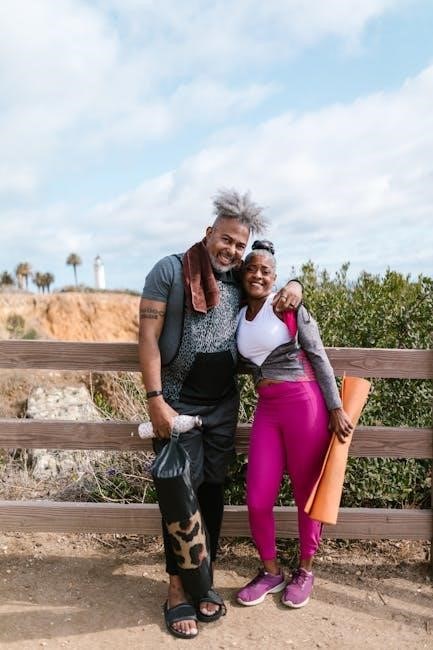
6․2 Massage and Physical Therapy
Massage and physical therapy are effective complementary treatments for sciatica in seniors․ Massage helps reduce muscle tension, improve circulation, and relieve pressure on the sciatic nerve․ Techniques like soft tissue manipulation and myofascial release can target tight muscles, such as the piriformis, often implicated in sciatica․ Physical therapy involves tailored exercises to strengthen core muscles, enhance flexibility, and improve posture, reducing nerve irritation․ A licensed therapist can design a program that aligns with the senior’s mobility level and health conditions, ensuring safe and progressive recovery․ Regular sessions can enhance the benefits of home exercises, promoting long-term pain relief and improved mobility․
6․3 Low-Impact Activities
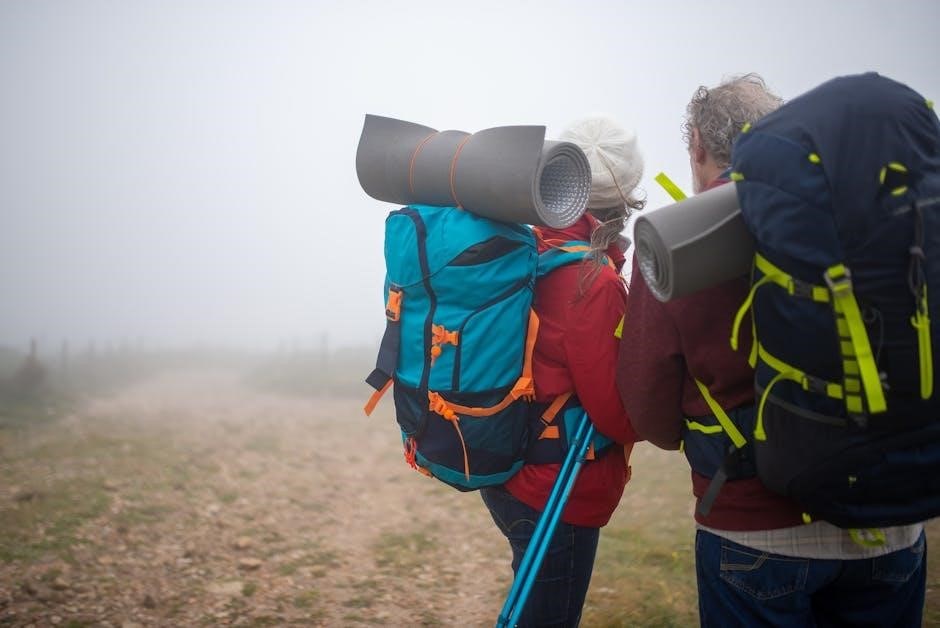
Low-impact activities are essential for managing sciatica in seniors, as they promote healing without excessive strain․ Swimming, water aerobics, and gentle yoga are ideal, as they strengthen muscles and improve flexibility while minimizing joint stress․ Tai Chi and walking are also beneficial, enhancing balance and mobility․ These activities can be adapted to individual fitness levels, ensuring safety and comfort․ Regular engagement in low-impact exercises complements stretching routines, fostering overall well-being․ Seniors should consult healthcare professionals to tailor activities to their specific needs, ensuring a balanced approach to managing sciatica effectively․
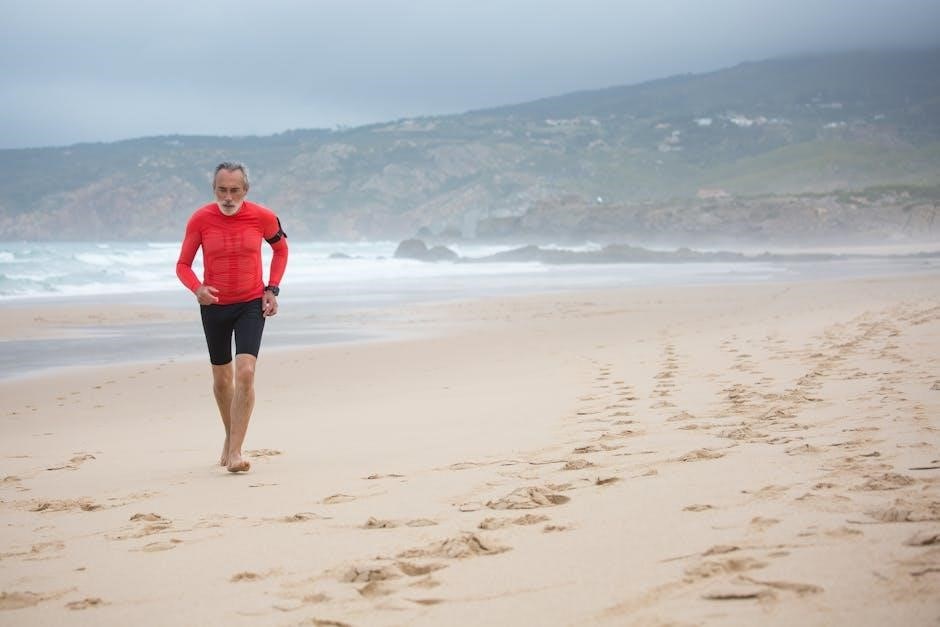
Sciatica Exercises for Seniors PDF Resources
Printable PDF guides provide structured routines for sciatica exercises, offering convenience for home use․ They include detailed instructions and visuals, ensuring safe and effective practice for seniors․
7․1 Importance of Printable Guides

Printable guides are invaluable for seniors managing sciatica, as they provide clear, structured exercise routines․ These resources often include detailed instructions, images, and step-by-step directions, making it easier for seniors to follow along independently at home․ The portability of PDF guides ensures exercises can be performed in any setting, promoting consistency․ Many guides are tailored to accommodate physical limitations, offering modifications for different mobility levels․ Additionally, printable formats allow seniors to track progress and set achievable goals․ The accessibility of these materials empowers seniors to take control of their sciatica management, reducing pain and improving mobility without reliance on digital devices․ This simplicity makes printable guides a practical and effective tool for maintaining a healthy exercise routine․
7․2 Where to Find Reliable PDFs
Reliable PDF guides for sciatica exercises tailored to seniors can be found through reputable health websites, physical therapy clinics, and senior-focused fitness platforms․ Official health organizations, such as the NHS, often provide downloadable resources․ Additionally, many orthopedic and geriatric care websites offer free or low-cost PDFs designed specifically for older adults․ Seniors can also consult with their healthcare providers, who may recommend or provide curated exercise guides․ Online platforms like senior fitness communities and wellness websites frequently share printable materials․ Ensuring the PDFs are created by licensed professionals, such as physical therapists, guarantees safety and effectiveness․ Always verify the source to avoid unqualified or potentially harmful content․
7․3 Using PDF Resources Effectively
To maximize the benefits of sciatica exercises for seniors PDFs, start by reviewing the guide thoroughly․ Focus on understanding proper form and technique, as incorrect posture can worsen symptoms․ Begin with gentle stretches, such as the Figure Four or Seated Glute Stretch, to ease tension without overexertion․ Incorporate breathing techniques to enhance relaxation and reduce discomfort․ Seniors should prioritize consistency, performing exercises 2-3 times weekly․ If pain increases, stop immediately and consult a healthcare professional․ Use the PDF as a visual aid, following step-by-step instructions for each movement․ Consider printing the guide for easy reference during workouts․ Combining these exercises with other therapies, like heat or ice, can further alleviate symptoms and improve mobility safely;
Sciatica exercises for seniors, guided by PDF resources, can significantly ease pain and improve mobility․ For further reading, explore NHS-recommended exercises and consult healthcare professionals for personalized plans․
8․1 Summary of Benefits
Sciatica exercises tailored for seniors offer numerous benefits, including pain relief, improved mobility, and enhanced overall well-being․ These exercises, often detailed in downloadable PDF guides, are designed to strengthen core muscles and alleviate tension in the sciatic nerve․ By incorporating gentle stretches and low-impact activities, seniors can experience reduced discomfort and improved flexibility․ Consistency in performing these exercises not only helps manage symptoms but also prevents future flare-ups․ Additionally, many resources emphasize the importance of proper posture and breathing techniques, further contributing to a better quality of life․ Consulting healthcare professionals ensures personalized plans, making these exercises safe and effective for older adults․ Regular practice can lead to significant improvements, empowering seniors to maintain independence and enjoy daily activities without hindrance․
8․2 Encouragement and Next Steps
Embracing sciatica exercises can be a transformative step for seniors, offering relief and renewed independence․ Start by consulting a healthcare professional to tailor a routine to your needs․ Downloadable PDF guides provide clear, accessible instructions, making it easy to begin․ Begin with gentle stretches and gradually incorporate strengthening exercises․ Consistency is key, even if progress is slow․ Celebrate small victories, like improved mobility or reduced pain, to stay motivated․ Encourage friends or family to join you for support; Remember, managing sciatica is a journey, and every effort contributes to a healthier, more active lifestyle․ Take the next step today and empower yourself to reclaim comfort and confidence!
8․3 Recommended Reading and References
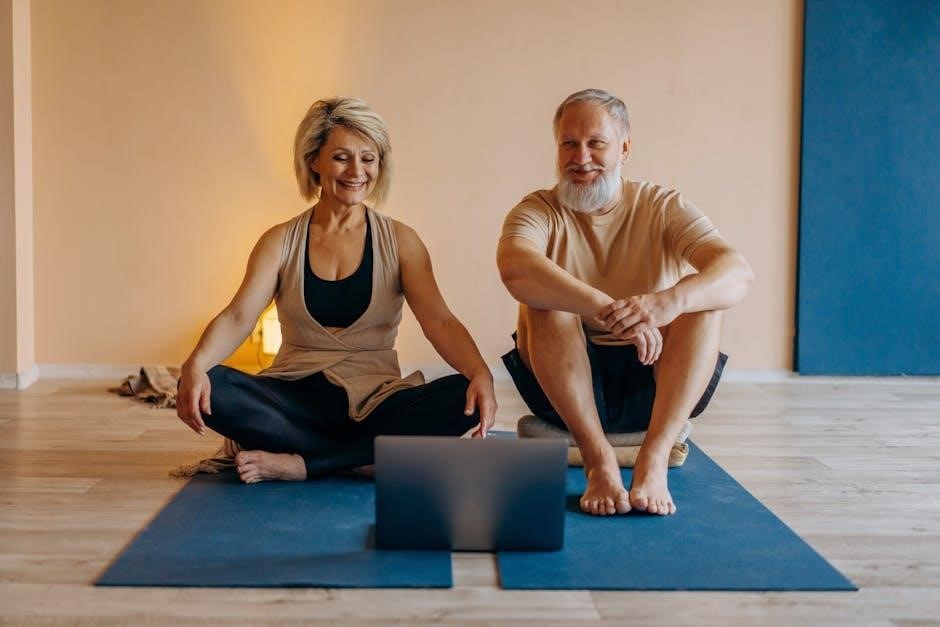
For further guidance, explore NHS-recommended exercises for sciatica, offering evidence-based routines․ Visit physical therapy websites for detailed videos and PDF guides tailored for seniors․ Consider downloading “Sciatica Exercises for Seniors: A Comprehensive Guide” for step-by-step instructions․ Additionally, consult “Low-Impact Fitness for Seniors” to explore complementary activities․ These resources provide expert advice, safety tips, and progress tracking․ Always consult a healthcare professional before starting new routines to ensure safety and effectiveness․ Leveraging these references can enhance your understanding and adherence to sciatica management, helping you achieve long-term relief and improved mobility․